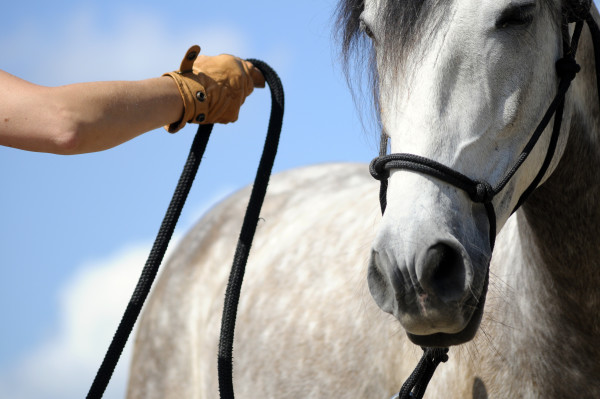Home > Horse World > How medical students learn horse sense
How medical students learn horse sense
- September 6, 2024
- ⎯ Christine Barakat
Horses are helping to train the next generation of medical doctors—but not in the ways you might think. Instead of serving as models for comparative physiology or subjects for the practice surgeries, they are being used to teach medical students how to cope with ambiguity.
Since 2014, students at the Warren Alpert Medical School of Brown University in Rhode Island have been given the option of participating in a three-and-a-half hour workshop that uses horses to illustrate the real-world uncertainties that can make diagnosis difficult.
“Tolerance of ambiguity is important in clinical practice because medical education often trains students to think in black-and-white with definitive answers on tests and other schoolwork,” says Daniel S. Jamorabo, MD, a gastroenterologist who helped develop the program. “Yet trainees have to be able to understand the nuances of a patient’s symptoms, labs, imaging, etc., to build a differential diagnosis.”

Medical schools have long sought better ways to prepare students for these uncertainties. A chance meeting between Kevin Liou, MD, and Connie Crawford, a professor at Brown University’s theater department, led to an inspired solution. “We met at a lecture on improvisation in the medical field,” says Crawford, an avid equestrian who often uses horses when teaching her classes on acting. “I told him of the work I do with horses and our adventure began.”
In the workshops, medical students travel to a local boarding farm and are introduced to horses by Crawford and trainer Alyshia Gaw. “Horses are foreign to most of the students, thereby offering greater areas of ambiguity and concern,” says Crawford. “They are large and easier to read than smaller animals and they are more cooperative than other animals.”
Under Crawford’s and Gaw’s guidance, the medical students participate in two group activities. In the first, they observe and interact with the horses to make a “diagnosis” that captures the horse’s personality. In the second activity, they try to persuade the horse to take three steps forward and backward and to lower his head. Although the program uses school horses who are accustomed to handling, the students find the tasks challenging, says Crawford. “We examine the process as it is happening. Students are given many opportunities to discuss and then practice ways of communicating and coping with any frustrations that arise.
“I believe that horses offer an excellent analogy for human patients,” continues Crawford. “The horse models a patient who does not speak our language, is from a different culture and is in a stressful situation. When a medical student unfamiliar with horses interacts in a foreign setting with foreign beings, their own self-preservation heightens. Two beings with strong self-preservation offer wonderful complications of communication. Working with students to be mindful and compassionately aware while dealing with new situations that could be dangerous develops their confidence.”
To test the efficacy of the program, the school organized a session in which the students completed Budner’s Tolerance of Ambiguity Scale before and after the training. This scale is a validated method of assessing change in ambiguity tolerance among medical trainees by measuring their reactions to various statements. The data showed that all the participants had a lower post-workshop score, indicating a greater tolerance of ambiguity, but this difference was statistically significant only among first-year students. This, say the educators, was likely due to the larger sample of first-year students but may also reflect greater flexibility during earlier years of medical training.
Although it may not always be feasible, Crawford believes other medical students could benefit from similar programs. “Personally, I believe that horse work is extremely valuable,” she says. “I would like to see more in-depth practice offered to medical students who want to work directly with patients. The skills honed are profoundly valuable to improving patient outcome.”
Reference: “Foreign bodies: Is it feasible to develop tolerance for ambiguity among medical students through equine-facilitated learning?” Medical Teacher, March 2019
Don’t miss out! With the free weekly EQUUS newsletter, you’ll get the latest horse health information delivered right to your in basket! If you’re not already receiving the EQUUS newsletter, click here to sign up. It’s *free*!How Medical students learn horse sense





